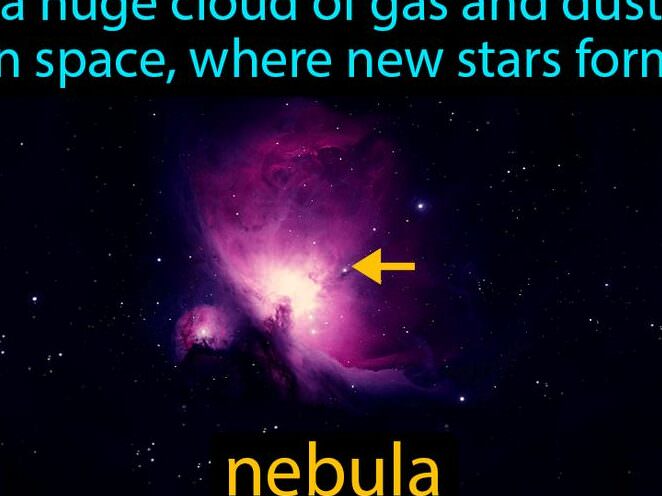
In fact, new stars are not recently born or emerged stars. This is a common misconception among those who are not familiar with our universe.
In the field of astronomy, the term “new star” refers to a star that has experienced a significant increase in luminosity and brightness. In fact, these characteristics can increase more than 100 times in terms of energy emission and approximately 12 stellar magnitudes in terms of brightness.
Interestingly, the concept of a new star was introduced by astronomer Tycho Brahe. He observed the supernova SN 1572 in the Cassiopeia constellation and referred to it as a new celestial body.
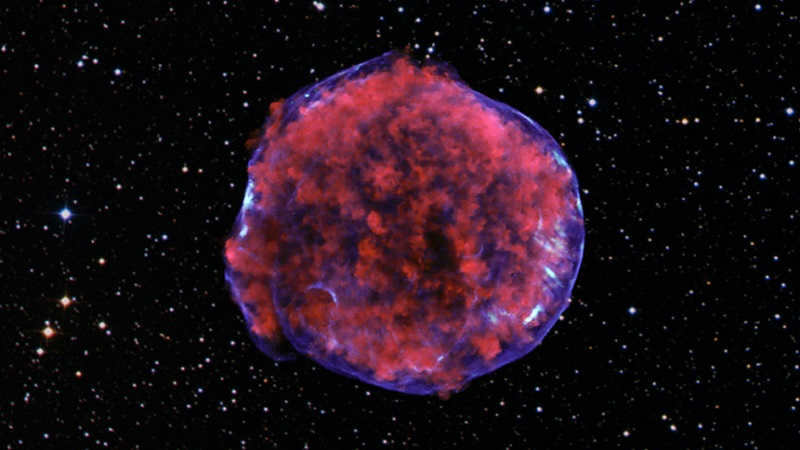
By the way, every newly discovered star is a close binary system. It has been revealed that these stars are always formed by a white dwarf and a main-sequence star or a red giant. It has also been observed that the dwarf companion receives matter from its neighboring star, which results in the formation of an accretion disk.

The structure of an accretion disk can be described as a region that is formed by matter orbiting around a central body.
What is the reason for the change in brightness of new stars
As mentioned before, a white dwarf receives matter from its companion. With an increase in the amount of matter, its hydrogen layer contracts and therefore heats up. This leads to a rise in temperature and heating of helium. Since this process occurs abruptly and rapidly, a new star flares up. At the same time, the surface area that conducts energy also increases. As a result, the brightness and radiance of the object intensify.
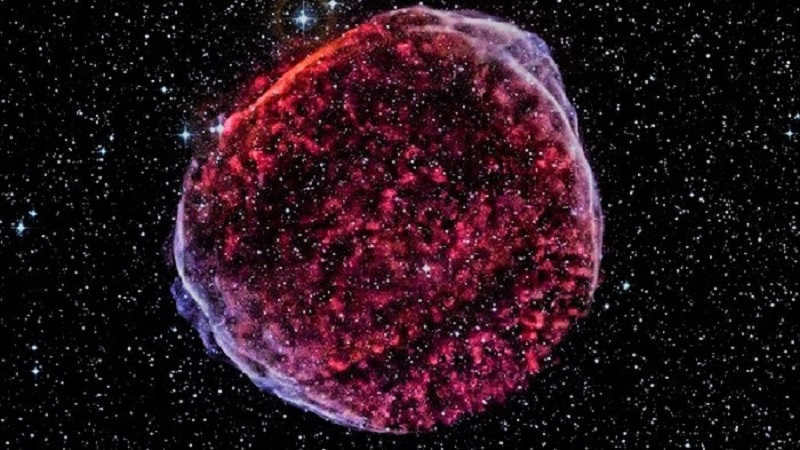
Classification of new stars
We can categorize new stars in two different ways. Before 1925, their names were based on the letter index of their discovery order in a specific constellation, along with the name of that constellation.
However, since 1925, their names include the index V, the serial number of the discovery within the constellation, and the constellation’s name.
In some cases, stellar bodies are discovered and presumed to be new. Until their discovery is confirmed, they are labeled with the index PNV and their celestial coordinates. In simpler terms, this category of stars is also referred to as variable objects.
Scientists classify new stars into two types:
Variable stars that explode
These stars are actually luminous bodies that experience periodic eruptions. This means that they have a recurring nature.
During their increase in brightness to the maximum, they emit a violet color in the optical spectrum.
Traditional exploding stars
Unlike the previous type, these stars do not have repeated outbursts. However, the amplitude of their brightness is more distinct, and they reach their maximum value much faster. Just imagine, they can increase their brightness to a magnitude of 12 in a matter of hours.
Traditional stars are categorized based on the time periods between their flares. They can be:
By the way, recurrent stars belong to a very intriguing class of celestial bodies. They are known for their powerful flares, occurring with time intervals of several decades. In these events, the luminosity of the stars increases by approximately 10 magnitudes.
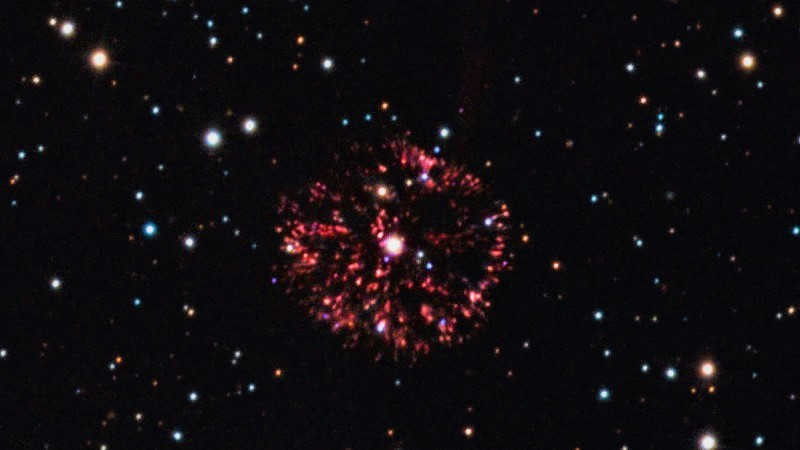
For centuries, people have been observing the formation and eruptions of new stars. However, in the last century, the discovery of new stars has become a constant occurrence. Nowadays, approximately ten new stars can be discovered in a year.
This increase in discoveries may be attributed to the fact that new stars often form in binary systems, which are abundant in our Universe.
The study of these celestial bodies continues to this day. In fact, there is an ongoing astronomical project called the E-Nova Project, which aims to investigate the eruptions of new stars. Additionally, amateur astronomers also take pleasure in observing these fascinating phenomena.

Since ancient times, humanity has been captivated by the enigmas of the universe. The field of astronomy has a special fascination with new and supernovae stars. This abstract-report provides an introduction to their key characteristics, origins, and mechanisms of formation. Initially, scientists believed that these celestial bodies emerged autonomously, but further research has unveiled a different nature of these cosmic entities.
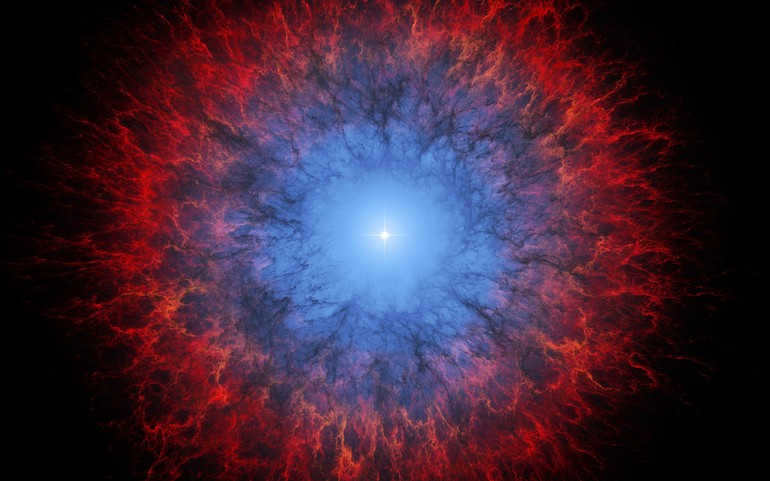
Discovery History
Around 5000 years ago, humans witnessed the appearance of a celestial body in the sky that rivaled the Sun in brightness. At the time, people believed that this phenomenon was a retribution for their sins. However, after a period of time, it vanished. The cuneiform tablets of the ancient Sumerians provide information about this occurrence.
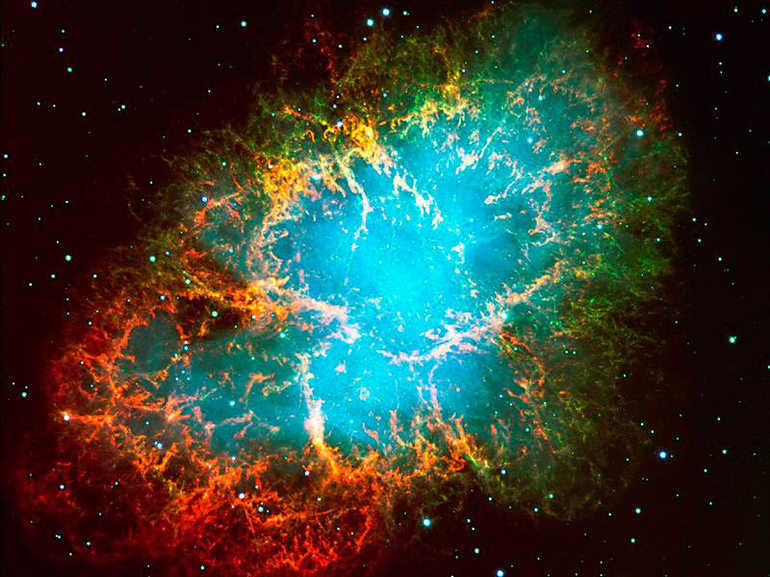
In the past, astronomers from China and Arabia documented the emergence of a celestial object that amazed observers with its brilliant luminosity for several weeks. At the time, people mistakenly believed that it was a newly formed star. Little did they know, this extraordinary phenomenon was actually the result of a cosmic explosion from an aging celestial body. Over the years, humans have witnessed the appearance of numerous bright celestial objects, each arising from different physical processes. The invention of telescopes revolutionized our understanding of these celestial occurrences, allowing scientists to determine their true nature.
Scientists refer to what is now known as a supernova or a new star as the flash that it emits. Initially, it was believed by experts that this occurrence was the result of a gas sphere exploding, leaving behind a black hole in its wake.
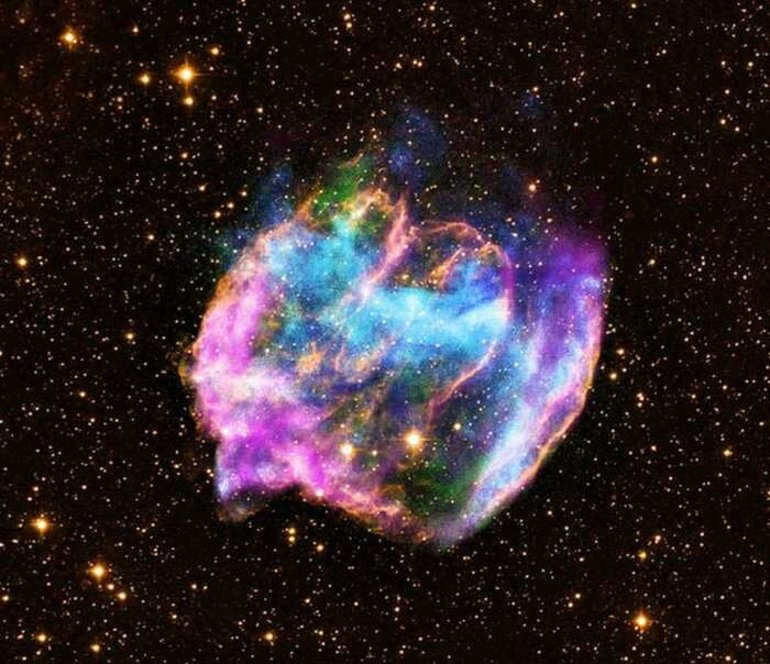
However, not all supernovae stars can be considered as the final stage of the life of massive celestial bodies. Initially, astronomers referred to new entities that emerged in an empty region of the sky and gradually faded away. Chinese sources mentioned such phenomena until the early 2nd millennium AD. However, among them, there were instances of the supernova variety.
Prior to the invention of telescopes, people could only observe faint celestial objects and bursts that resembled the birth of another luminary.
Advancements in technology have enabled a detailed examination of these phenomena and the identification of distinctions between supernovae and new stars.
The birth of a fresh radiance
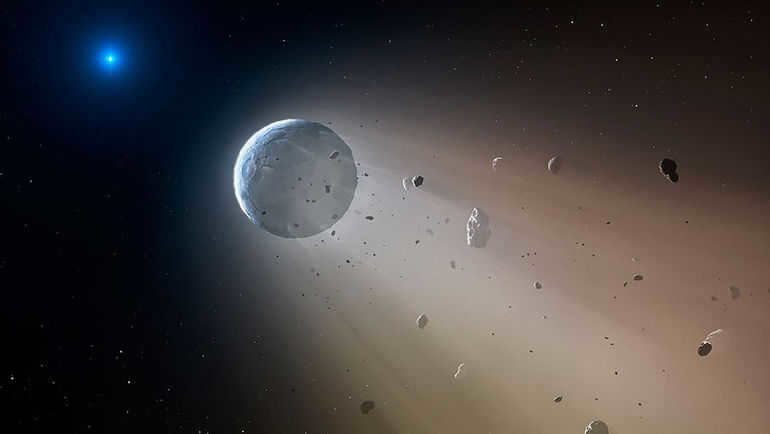
The smallest star receives matter from the outer layers of the largest luminosity, resulting in the creation of an accretion disk. This disk is formed by the interaction between the two stars. The gas that is accreted onto the white dwarf’s surface forms a layer rich in hydrogen. This hydrogen-rich layer is then heated by the flow of gas from the accretion disk, leading to the accumulation of hydrogen and an increase in temperature in the upper layer. These changes trigger thermonuclear reactions, causing carbon to be released to the surface of the white dwarf.
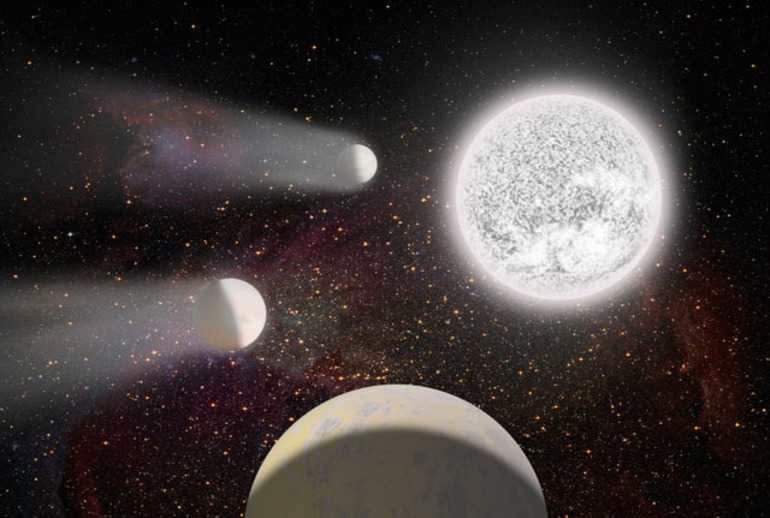
As time goes by, the thermonuclear reactions speed up and the star’s mass grows, leading to an explosion that ejects the outer layer of hydrogen into space.
Following this event, a new cycle of matter accumulation occurs on the white dwarf, culminating in a second eruption. The time between these explosions can range from tens to hundreds of years.
A flare causes the star system’s brightness to increase by thousands of times. What was once a faint object now becomes visible to the human eye. The flare reaches its peak in a matter of days and then gradually fades away. Afterward, the gas envelope surrounding the new star expands, a process that typically takes years. These phenomena occur periodically and can repeat themselves in the same system every decade.
Supernovae’s Physical Apperance
Supernova explosions are a phenomenon characterized by a sudden increase in brightness followed by a gradual decline. The peak luminosity of these celestial events is thousands of times greater than that of newly formed stars. This occurrence is a result of the evolution of certain cosmic objects. When a star explodes, it releases a significant amount of energy. Observing this phenomenon is possible only in outer space, as it is obstructed by large amounts of gas and dust.
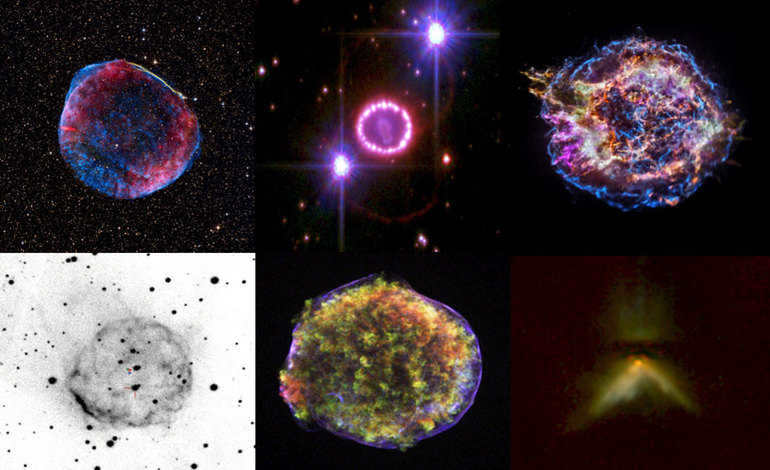
Scientists have been puzzled for a long time about the nature of these celestial entities, as their formation can only be witnessed during the actual event. Currently, there are two identified scenarios that result in these eruptions:
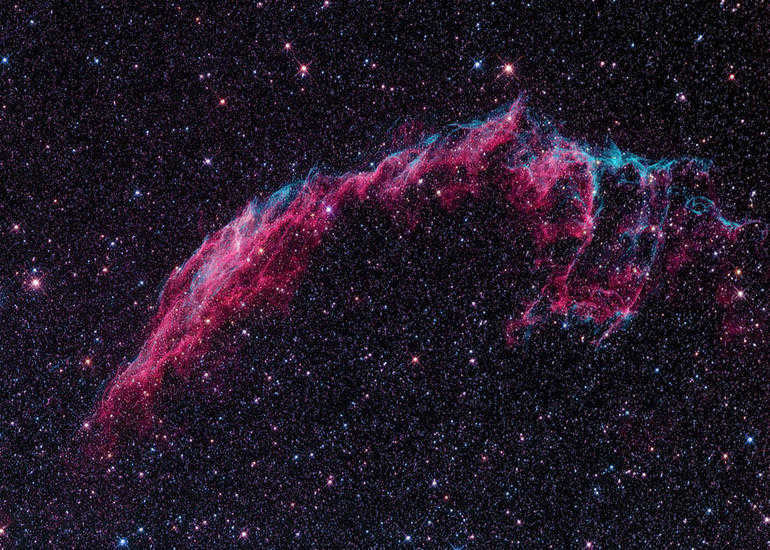
- Following the detonation of a celestial entity, a substantial quantity of material is expelled into the vastness of outer space from the outer layer of its shell. This remaining material then coalesces to form a neutron star.
- The detonation is regarded as the ultimate phase of the entity’s existence. As time elapses, the fuel supply within the gaseous sphere becomes depleted. A portion of the star’s mass enters the nuclear region, where it accumulates. As the entity can no longer contain this mass through its gravitational pull, an expansion occurs, ultimately leading to a detonation.
Experts analyze the data gathered on spectra and light curves in a comprehensive manner. By examining the remains of stars, they are able to construct detailed and logical models and determine the conditions of celestial eruptions.
Supernovae are regarded as the creators of life in the cosmos.
Their immense explosions give rise to the creation of gas and dust clouds and nebulas, which subsequently give birth to new celestial bodies. Moreover, supernovae expel heavy elements into the surrounding space, contributing to the formation of chemical elements that are heavier than iron. Following the eruption, these explosions disperse oxygen, nitrogen, and other vital components necessary for organic life.
Distinctive Categories
Experts categorize supernova stars into multiple groups and subtypes. The classification is based on the unique characteristics that these cosmic entities possessed before undergoing a powerful explosion. For instance, celestial bodies lacking hydrogen are classified as subclasses lb and lc within the first category. It is possible that the star lost a portion of its outer layer containing this element during its evolution within a binary system. It is worth mentioning that objects belonging to subtype lc do not contain any helium.
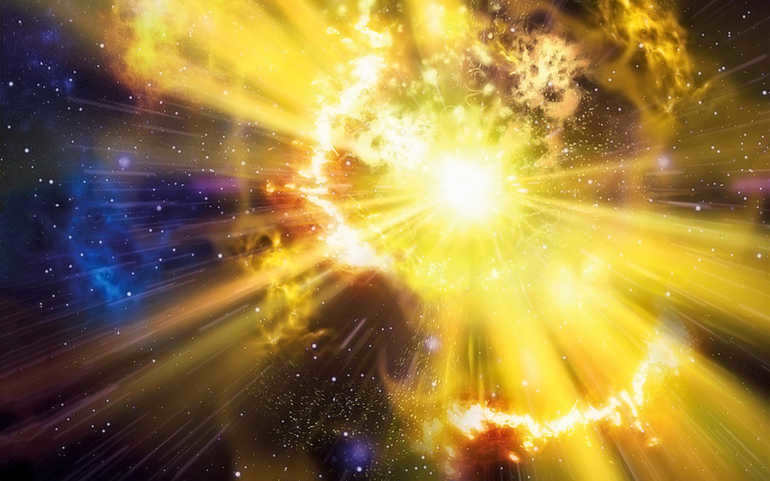
Despite the hydrogen layer being lost, the remaining stars adhere to strict size and mass limits. When a specific critical stage is reached, thermonuclear reactions take place in succession. This phenomenon accounts for the similarities observed between objects belonging to subclasses lb and lc. The maximum luminosity of these stars is 1.5 billion times greater than that of the Sun. This peak is achieved within 2-3 days and then gradually diminishes over the course of several months.
Before the eruption, the envelope of the newly formed stars contained a layer of hydrogen and helium, the boundaries of which were determined by the mass and other properties of the celestial body. These characteristics account for the diverse nature of supernovae, which can vary in brightness from tens of millions to billions of times the luminosity of the sun. The manner in which this brightness changes can also differ.
Explosions of Hypernovae
Astronomers also classify hypernova bursts. Their power surpasses that of regular supernovae by several magnitudes. Hypernova stars are the result of the explosion of massive entities known as hypergiants. These gas formations can have a mass of up to 150 times that of our Sun.
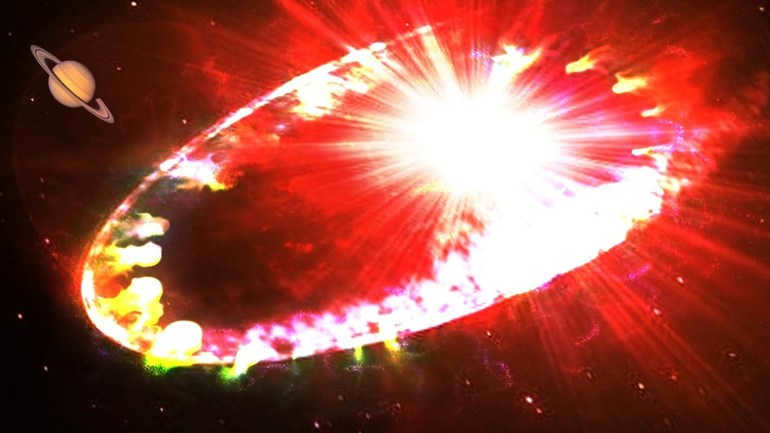
Scientists speculate that these objects are created as a result of antimatter annihilation, the collision of two massive stars, or the formation of a quark star.
Hypernovae stars are a topic of great interest not only to researchers, but also to amateur astronomers.
Celestial bodies often give rise to gamma-ray bursts. These events can last from fractions of a second to several hours and are considered rare electromagnetic occurrences. In a matter of seconds, a gamma-ray burst can release an amount of energy equivalent to the mass of the Sun. Experts continue to investigate the nature of this phenomenon.
Exploring the Intricacies of Research
Supernova-type occurrences are regarded as a seldom-seen event. Our galaxy is home to over 100 billion stars, yet only a handful of bursts can transpire within a century. According to historical accounts, humans have witnessed this phenomenon merely six times over the course of the past two millennia.
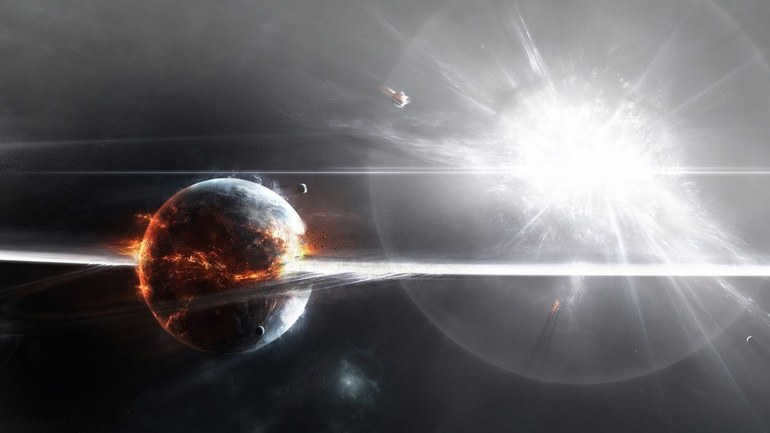
The most recent sighting of a supernova star occurred in 1987 in one of the satellites of our Milky Way galaxy known as the Large Magellanic Cloud. In other galaxies, scientists observe an average of 60 starbursts each year.
Our understanding of the nature and characteristics of these celestial objects is still limited, as we have yet to witness the events leading up to their explosive demise. Predicting these phenomena is challenging, with scientists suggesting that any star has the potential to explode within millions of years. There are even speculations that Betelgeuse, a prominent star, may experience such an eruption within this century.
Hypernovae flares, on the other hand, are even more elusive. In our galaxy, this extraordinary phenomenon can only be observed once every 100,000 years.
However, scientists have observed gamma-ray bursts, which occur due to the intense explosion of these celestial bodies, in various regions of the cosmos. Given the vast number of galaxies present, it is not surprising that these outbursts are documented by experts on a daily basis.
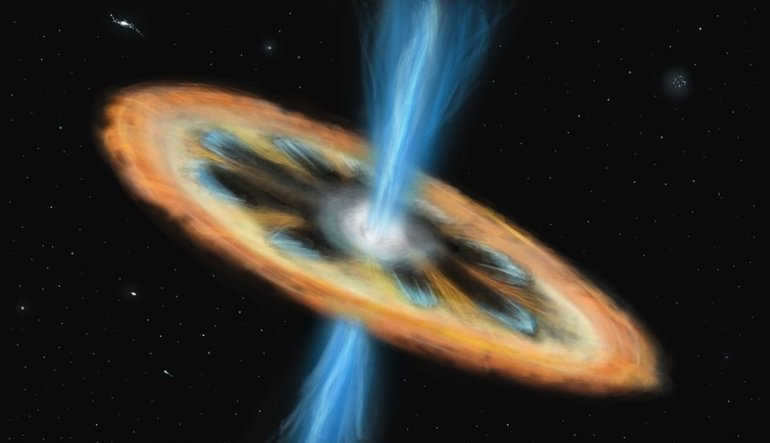
Astronomers speculate that the present-day Earth is not under threat from exploding stars, although they have had a significant impact in the distant past. For instance, it is believed that a gamma-ray burst in our galaxy around 440 million years ago could have caused a mass extinction event on Earth.
Since the 1960s, scientists have been exploring the potential benefits of supernovae. Some scientists propose that the peak luminosity of these celestial bodies can be utilized to make important discoveries. Presently, supernovae play a crucial role in providing information about cosmic distances. Furthermore, astronomers are actively developing methodologies to reconstruct the history of these phenomena.
No Comments/ 1121
Supernovae are a relatively recent phenomenon. In various sources, one can still come across an explanation of the distinction between novae and supernovae. Throughout history, “new” stars were referred to as stars that appeared in the sky in a seemingly empty space and gradually faded away. This was how they appeared to Earth observers. The first recorded “new” star dates back to the second millennium BC in Chinese chronicles. For instance, the supernova observed by Tycho Brahe in 1571 was later referred to as a “new star.”
Ancient observers did not consider that a bright celestial body in the sky could be the result of various processes. It was only with the invention of telescopes that these distinctions were made. It was discovered that what we now call a supernova is the explosion of a star.
About new stars and supernovae
The term “supernova” was not coined until the 1930s. It was initially used by Walter Baade and Fritz Zwicky from the Mount Wilson Observatory to describe an explosion-like phenomenon they observed in S Andromedae (also known as SN 1885A), which occurred in the Andromeda galaxy. They proposed that supernovae occur when regular stars collide with neutron stars.
There appears to be some confusion between novae and supernovae. Certain sources classify all exploding stars as supernovae, categorizing them as types II, Ia, Ib, and Ic. Other sources classify type Ia as new stars, while supernovae are further divided into types I and II.
However, I believe the term “new” is outdated. The nomenclature has evolved, and all such explosions in the Universe are now referred to as supernovae. The distinction between them lies in the following:
- There are instances when a small and dense star, known as a white dwarf, experiences a thermonuclear explosion on its surface. This explosion can be compared to a thermonuclear explosion.
- Alternatively, in some situations, a massive star undergoes a catastrophic collapse of its core, resulting in the complete destruction of the surrounding layers.
When it comes to the first case, the outburst signifies the emergence of a new star, while in the second case, it signifies the demise of the star.
Observing the History of Supernovae
Supernovae have been documented by different societies throughout history, even predating the invention of the telescope. One of the earliest recorded supernovae, known today as RCW 86, was observed by Chinese astronomers in 185 AD. Their ancient records indicate that this celestial event, referred to as a “new star,” remained visible in the sky for an impressive eight months.
Prior to the availability of telescopes in the early 17th century, the Encyclopedia Britannica documents the recording of seven supernovae, marking significant milestones in our understanding of these powerful cosmic explosions.
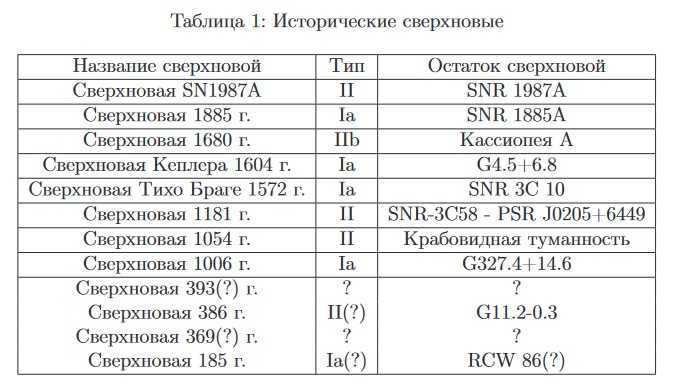
The Crab Nebula is the result of a supernova, which is one of the most well-known stellar explosions in history. Chinese and Korean astronomers documented this event in 1054, and there is evidence to suggest that southwestern Native American tribes may have witnessed it as well, as depicted in rock paintings discovered in Arizona and New Mexico. The brightness of the supernova was so intense that it could even be seen during daylight hours by astronomers.
There have been several other supernovae that were discovered prior to the invention of the telescope. These occurrences took place in the years 393, 1006, 1181, 1572 (which was extensively studied by the renowned astronomer Tycho Brahe), and 1604. Brahe documented his observations of a celestial phenomenon he referred to as a “new star” in his book De Stella Nova, which subsequently led to the term “nova” being used. It is important to note that a nova is distinct from a supernova. While both events involve a sudden increase in brightness and the ejection of hot gases, a supernova is a catastrophic explosion that signifies the end of a star’s existence.
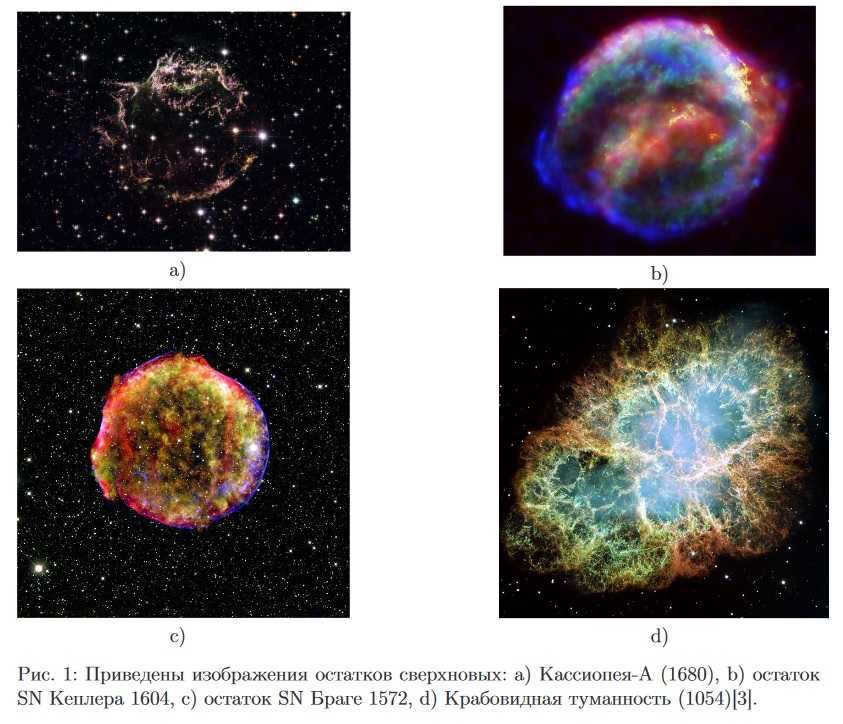
Categories of supernovae
One of the initial inquiries among researchers studying supernovae was whether they are identical, or if there are notable differences that can be classified.
Through analysis of supernovae spectra, significant conclusions have been drawn. Type I supernovae exhibit shells that are nearly devoid of hydrogen, while the composition of the shells in Type II supernovae closely resembles that of the solar atmosphere.
The mechanisms behind the explosions of Type I and Type II supernovae differ and will be explained below.
In simpler terms, Type I supernovae involve the explosions of white dwarfs with masses up to 1.4 times that of the Sun, whereas Type II supernovae originate from stars with an initial mass 8-15 times greater than the Sun.
Type I supernovae have a shorter duration of peak brightness (2-3 days) compared to Type II supernovae. There is no hydrogen present in the star’s spectrum. Depending on the composition of the spectrum, supernovae of the first classification type can be subdivided into subtypes Ia, Ib, and Ic. In objects of types Ib and Ic, hydrogen is initially absent. Ic is distinguished from the other subtypes by the lack of helium traces in its spectrum.
The main characteristic of type II supernovae is the presence of hydrogen traces in their spectrum. Type II supernovae can be further divided into the following subtypes: II-L, II-P, IIn, and IIb.
Supernova explosion
The life of a blazing celestial body is characterized by an unyielding conflict between opposing forces. The culmination of this struggle culminates in the release of an immense amount of energy.
The process of a Type I supernova outburst
In the case of less massive stars, their evolution takes a different path. Once hydrogen is depleted, the core transitions to helium and the process of converting helium into carbon ensues. However, the core does not reach the required temperature to initiate fusion reactions involving carbon. Consequently, the core fails to emit sufficient energy, causing it to contract. This contraction is halted by the electrons within the core’s matter. As a result, the star’s core transforms into what is known as a “white dwarf”, while the outer envelope disperses into the surrounding space as a planetary nebula.
If the white dwarf exists in a close binary star system, it is possible for matter to transfer from a regular star to the white dwarf. Over time, the mass of the white dwarf increases until it surpasses a certain threshold, leading to an explosion. During this explosion, carbon and oxygen undergo rapid thermonuclear fusion, transforming into radioactive nickel.
The collapsed star then releases an expanding shell in which the radioactive nickel decays into cobalt and eventually iron. This decay process provides the energy that causes the shell to glow. This is the mechanism by which Type Ia supernovae occur.
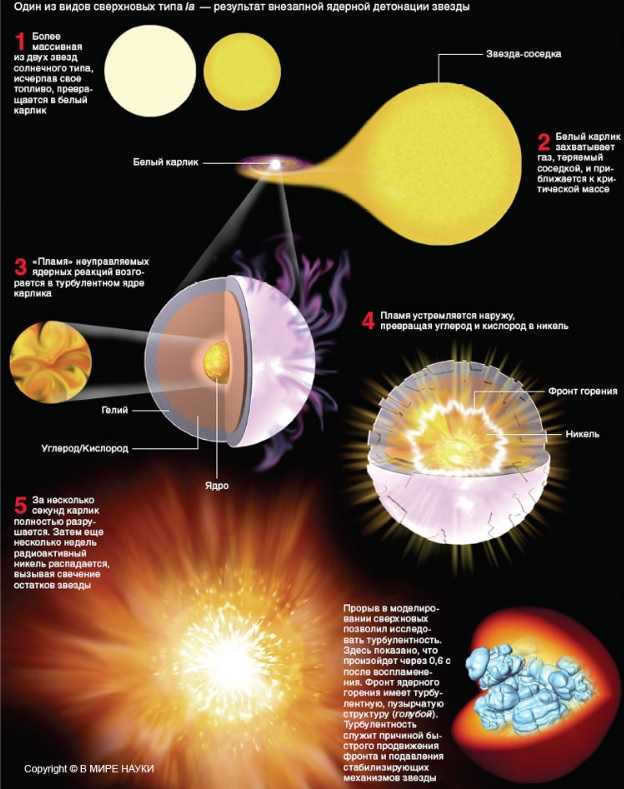
Mechanism of Type II supernova explosion
As gravity compresses the star towards its center, it exerts immense pressure, attempting to transform the massive ball of fiery gas into a compact sphere. Simultaneously, thermonuclear reactions occur within the star’s core and on its surface, striving to tear the celestial body into smaller fragments. The young star contains vast reserves of hydrogen, and due to the ongoing process of helium formation from hydrogen atoms, the forces of gravity and thermonuclear reactions find a state of relative equilibrium.
However, all good things must come to an end, and after a few billion years or so, the hydrogen stores run dry and the once vibrant star begins to age. The center transforms into a fiery ball of helium, while the hydrogen at the edges fizzles out. In its final throes, the remaining hydrogen reserves are depleted, leaving the celestial luminary powerless against its own gravitational pull. The star collapses, shrinking hundreds of thousands of times in size. Simultaneously, the vast majority of its stellar energy is unleashed into the surrounding space.
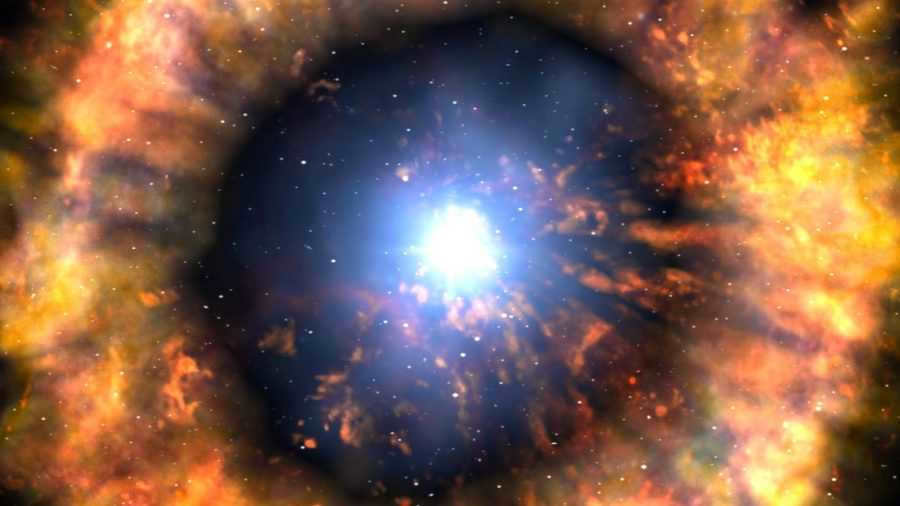
The final gasp of a dying celestial body manifests as a brilliant burst of energy, which is documented and described by observer-astronomers as the genesis of a supernova. This immensely powerful explosion surpasses the luminosity of an entire galaxy, and the remnants of the cosmic wind disperse heavy cosmic elements throughout interstellar space.
New planets are formed in distant star systems, hundreds of light-years away from the site of this cosmic tragedy, using the remnants of the deceased star. On our own planet, substances such as iron and aluminum are remnants of a supernova star that once perished. Following the explosion, the star transforms into either a neutron star or a black hole, depending on its original mass.
Maybe they will ignite tomorrow
There is a complete list that contains potential supernova stars. Of course, it is quite challenging to accurately predict when the explosion will take place. Here are the closest known candidates:
- IKPegasus. This binary star is located in the Pegasus constellation and is up to 150 light-years away from us. Its companion is a massive white dwarf that has already ceased fusion energy production. When the primary star becomes a red giant and expands its radius, the dwarf will begin to accumulate mass from it. Once its mass reaches 1.44 solar masses, a supernova explosion may occur.
- Antares. A red supergiant in the Scorpius constellation, 600 light years away from us. Antares is accompanied by a hot blue star.
- Betelgeuse. Located in the constellation Orion, Betelgeuse is a celestial object similar to Antares. It is situated at a distance of 495 to 640 light years from the Sun. Despite being a young star, approximately 10 million years old, Betelgeuse is believed to have already entered the carbon burnout phase. Scientists predict that within the next one or two millennia, we will have the incredible opportunity to witness the spectacular explosion of a supernova.
Effects on Earth
The detonation of a nearby supernova star will undoubtedly have an impact on our planet. Take Betelgeuse, for instance, when it goes supernova, it will increase in luminosity by about 10,000 times. For several months, the star will appear as a brilliant point, shining as brightly as the full moon. However, if any of Betelgeuse’s poles were to face Earth, we would receive a stream of gamma rays from the star. This would result in an intensification of the northern lights and a depletion of the ozone layer. The potential consequences for life on our planet could be highly detrimental. These are purely theoretical calculations and it is impossible to accurately predict the actual impact of this supergiant’s explosion.
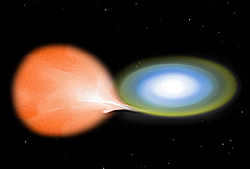
A nuclear explosion occurring in a white dwarf star is depicted in this artist’s rendering. The white dwarf star is shown accreting hydrogen from its larger companion star’s Roche cavity.
A transient astronomical event known as a new (plural new or new) can cause the sudden appearance of a bright, seemingly “new” star that gradually fades over a period of several weeks or months. The specific reasons for the dramatic emergence of a new star vary depending on the circumstances involving the two progenitor stars. However, all observed novae contain a white dwarf in a close binary system. The primary subclasses of novae include classical novae, recurrent novae (RNe), and dwarf novae. All of these are categorized as cataclysmic variable stars.
Classical nova eruptions are the most prevalent form. They are likely formed in a binary star system with a white dwarf and either a main-sequence, subgiant, or red giant star. When the orbital period falls within the range of a few days to one day, the white dwarf is in close proximity to its companion star, causing it to accrete matter onto its surface. As a result, a dense but shallow layer of congealed matter is formed. This layer primarily consists of hydrogen and is thermally heated by the hot white dwarf. Eventually, the temperature of this atmosphere reaches a critical point, leading to the ignition of rapid fusion reactions.
The abrupt surge in energy propels the atmosphere outward into the vast expanse of interstellar space, giving rise to a luminous shell resembling visible light during a stellar phenomenon and often misidentified as a “fresh” star in historical eras. Certain stellar events yield ephemeral remnants of the newly formed star, which endure for a span of several centuries. The cyclic mechanisms underlying a nova are akin to those observed in a classical nova, with the exception that thermonuclear ignition can reoccur due to the potential for the companion star to once again supply the dense atmosphere of the white dwarf.
New stars are often discovered in the sky along the path of the Milky Way, particularly near the observed galactic center in Sagittarius. However, they can be found anywhere in the sky. They are much more common than galactic supernovae, with an average of about ten new stars being discovered each year. Most of these new stars are only detected through telescopes, and they may only be visible to the naked eye once every 12 to 18 months. Only a few new stars reaching first or second magnitude are found in a century. The most recent bright new star was V1369 Centauri, which reached a stellar magnitude of 3.3 on December 14, 2013.
Origin of the Term
In the sixteenth century, the astronomer Tycho Brahe made an observation of the supernova SN 1572 in the constellation Cassiopeia. He documented this event in his book De nova stella (Latin for “relatively new star”), which ultimately led to the adoption of the term “new”. In his work, Brahe argued that a neighboring object must be in motion relative to fixed stars, and the new star must be located at a great distance. Although the event in question was a supernova and not a nova, the terms were considered interchangeable until the 1930s. From that point forward, new stars were classified as classical novae in order to differentiate them from supernovae, as their causes and energies were believed to be distinct based solely on observational data.
While the term “stella nova” translates to “new star”, new stars are typically formed by white dwarfs, which are the remnants of very old stars.
Evolution of newly formed stars in the stellar realm
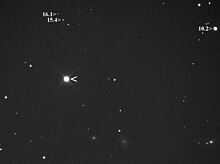
Nova Eridani 2009 has an apparent magnitude of approximately 8.4.
The process of forming potential new stars starts with a binary system consisting of two main-sequence stars. Eventually, one of the stars undergoes a transformation into a red giant, leaving behind a white dwarf core that continues to orbit the other star. The second star, which could be either a main-sequence star or an aging giant, begins to shed its outer shell onto the white dwarf as it moves beyond its Roche cavity. This results in the white dwarf gradually accumulating matter from the outer atmosphere of its companion star, forming an accretion disk. The accreted matter then enters the atmosphere of the white dwarf. Due to the white dwarf being made up of degenerate matter, the accreted hydrogen does not expand, but its temperature rises. When the temperature of this atmospheric layer reaches approximately 20 million K, uncontrolled fusion takes place, initiating nuclear combustion through the CNO cycle.
Hydrogen fusion can take place in a steady manner on the surface of the white dwarf for a limited range of accretion rates, resulting in the generation of ultra-soft X-ray radiation. However, under most conditions of the binary system, hydrogen combustion is thermally unstable and quickly converts significant quantities of hydrogen into different, heavier elements in an unregulated reaction, unleashing tremendous amounts of energy. This expels the remaining gases from the surface of the white dwarf and generates an incredibly intense burst of illumination.
The rate at which the maximum brightness can increase can vary greatly. This phenomenon is associated with the velocity class of the newly formed star. However, once the peak is reached, the brightness gradually diminishes. The duration it takes for a new star to decrease in brightness by approximately 2 or 3 magnitudes from its maximum optical brilliance is utilized to categorize it according to its velocity class. Swift novae usually experience a decay to 2 magnitudes within a span of less than 25 days, whereas tardy novae will require over 80 days.
Despite their high intensity, the amount of material ejected into new stars is typically only about 1/10000 of a solar mass, which is relatively small compared to the mass of a white dwarf. Additionally, only 5% of the accreted mass is consumed during the power ejection. However, this energy is sufficient to propel the ejection of a new star at velocities of several thousand kilometers per second – higher for fast new stars compared to slow ones – while also causing a simultaneous increase in brightness from a few times that of the sun to 50,000 to 100,000 times that of the sun. In 2010, scientists utilizing NASA’s Fermi Gamma-ray Space Telescope made the discovery that the new star is capable of emitting gamma rays (>100 MeV).
Over time, a white dwarf has the potential to generate multiple new stars as it continues to accumulate additional hydrogen from its companion star. RS Ophiuchi serves as an example of this phenomenon, having erupted on six separate occasions in 1898, 1933, 1958, 1967, 1985, and 2006. If a white dwarf approaches the Chandrasekar limit, it may eventually explode as a Type Ia supernova.
Sometimes there are new stars that are bright and close enough to Earth that they can be seen with the naked eye. One recent example of a very bright new star is Nova Cygni 1975. This new star appeared on August 29, 1975, in the constellation of Swan, which is about five degrees north of Deneb. Nova Cygni 1975 reached a stellar magnitude of 2.0, which is almost as bright as Deneb. There have been other recent examples as well, such as V1280 Scorpii, which reached a stellar magnitude of 3.7 on February 17, 2007, and Nova Delphini 2013. Another example is Nova Centauri 2013, which was discovered on December 2, 2013. It is still the brightest new star of this millennium, with a stellar magnitude of 3.3.
Helium novae
Helium novae, also known as stars experiencing a helium flash, are a unique category of celestial events characterized by the absence of hydrogen lines in their spectrum. These extraordinary phenomena are believed to occur when a white dwarf undergoes an explosion of its helium shell. The concept of helium novae was initially introduced in 1989, and the first recognized instance of such a star was observed in V445 Puppis in 2000. Since then, an additional four novae have been identified as potential helium novae.
Frequency of occurrence and its significance in astrophysics
Scientists in the field of astronomy have approximated that the Milky Way galaxy undergoes the formation of approximately 30 to 60 new stars annually. However, a recent study has suggested that the actual number is closer to 50 ± 27. The reason for the lower number of newly formed stars detected in the Milky Way each year, estimated to be around 10, is most likely due to the fact that distant new stars are obscured from view by the presence of gas and dust. In contrast, the Andromeda galaxy is observed to have a higher number of newly formed stars, with approximately 25 stars brighter than one-twentieth stellar magnitude being detected each year. Other nearby galaxies also exhibit smaller numbers of newly formed stars. As of 2019, a total of 407 probable new stars have been documented in the Milky Way galaxy.
Spectroscopic analysis of the emissions from recently discovered nebula stars has revealed an abundance of elements including helium, carbon, nitrogen, oxygen, neon, and magnesium. The impact of novae on the interstellar medium is relatively small, as they contribute only 1/50th of the material compared to supernovae and 1/200th compared to red giant and supergiant stars.
While recurrent novae like RS Ophiuchi (which have periods lasting several decades) are uncommon, astronomers theorize that most, if not all, new stars experience recurrent eruptions, albeit over longer timescales ranging from 1,000 to 100,000 years. The frequency of eruptions for a new star is more influenced by its mass rather than the rate of accretion onto a white dwarf; larger white dwarfs, with their stronger gravitational pull, require less accretion to trigger an eruption compared to smaller white dwarfs. As a result, the interval between eruptions is shorter for massive white dwarfs.
V Sagittae is an uncommon celestial object because it is projected to undergo a nova event around the year 2083, with a margin of error of approximately 11 years.
Astronomers made an announcement on May 27, 2020, revealing that exploding classical new stars are significant contributors to the production of lithium, an element found in galaxies.
Types
New stars are categorized based on the velocity of their light curve, as shown below:
- NA: fast novae, characterized by a rapid increase in brightness followed by a decrease of 3 stellar magnitudes, resulting in a brightness level of about ⁄ 16 within 100 days.
- NB: slow novae, with a gradual decrease in brightness of 3 stellar magnitudes lasting 150 days or more.
- NC: very slow novae, also referred to as symbiotic novae, remain at maximum light intensity for a decade or longer before slowly fading away.
- NR/RN: recurrent novae, which experience two or more eruptions separated by intervals of 10-80 years.
Residuals
Residuals: Understanding the leftovers
Residuals are an important concept in statistics and data analysis. They represent the difference between the observed values and the predicted values in a statistical model. In other words, residuals are the “leftover” or unexplained variation in the data after accounting for the effects of the model.
Residuals can be used to assess the goodness of fit of a model. If the residuals are randomly scattered around zero and show no distinct pattern, it suggests that the model fits the data well. On the other hand, if there is a pattern or trend in the residuals, it indicates that the model is not capturing all the underlying relationships in the data.
Residuals can also be used to detect outliers or influential points in the data. Outliers are observations that have a large influence on the model’s predictions. By examining the residuals, we can identify those observations that deviate significantly from the predicted values.
In addition, residuals can provide insights into the assumptions of a statistical model. For example, if the residuals exhibit heteroscedasticity (i.e., the variability of the residuals changes with the level of the predictor variable), it suggests that the model’s assumption of constant variance may be violated.
Overall, residuals are a useful tool for understanding and evaluating statistical models. They can help us assess model fit, detect outliers, and identify potential violations of model assumptions.
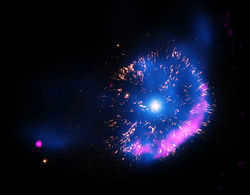
GK Persei : New 1901.
Some newly formed stars release visible nebulae, which are materials expelled during the explosion of a new star or from multiple explosions.
Newly formed stars as distance indicators
Newly formed stars can serve as a reference point for measuring distances. For instance, their absolute stellar magnitude is distributed bimodally, with a main peak at magnitude -8.8 and a smaller one at -7.5. Additionally, newly formed stars retain a similar absolute stellar magnitude 15 days after reaching their peak (-5.5). A comparison of distance estimates based on newly formed stars to those derived from cepheid variable stars in various nearby galaxies and galaxy clusters showed comparable accuracy.
Recurrent novae
Recurrent novae (RNe) are celestial objects that have been observed to undergo multiple eruptions of novae. As of 2009, there are ten known recurrent new stars in our Milky Way galaxy, and several more in extragalactic locations such as the Andromeda Galaxy (M31) and the Large Magellanic Cloud. One of these extragalactic new stars experiences an eruption every 12 months. When a recurrent new star erupts, it typically becomes about 8.6 magnitudes brighter, while a classical new star can become even more luminous by over 12 magnitudes. Below is a list of the ten known recurrent new stars in our galaxy.
| K. Reinmuth | 8.6–16.3 | 40 | 2000, 1941, 1917 | 24–59 | 20 | |
| L. E. Erro | 7.2–19.7 | 6 | 1987, 1949 | 38 | 33 | |
| T Coronae Borealis | J. Birmingham | 2.5–10.8 | 6 | 1946, 1866 | 80 | 74 |
| IM Normae | I. E. Woods | 8.5–18.5 | 70 | 2002, 1920 | ≤82 | 18 |
| RS Ophiuchi | W. Fleming | 4.8–11 | 14 | 2006, 1985, 1967, 1958, 1933, 1898 | 9–35 | 14 |
| K. Takamizawa (1998) | 9.5–17.5 | 9 | 1998, 1900 | 98 | 22 | |
| T Pyxidis | H. Livitt | 6.4–15.5 | 62 | 2011, 1967, 1944, 1920, 1902, 1890 | 12–44 | 9 |
| H. Dinerstein | 8.1–18.4 | 14 | 2019, 1990, 1962 | 28–29 | 1 | |
| U Scorpii | N. R. Pogson | 7.5–17.6 | 2.6 | 2010, 1999, 1987, 1979, 1936, 1917, 1906, 1863 | 8–43 | 10 |
| 9.4–19.3 | 7 | 2014, 1989, 1937 | 25–52 | 6 |
Novae beyond our galaxy
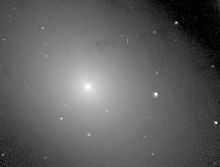
Latest Discoveries in the Andromeda Galaxy
Discovering new stars is a frequent occurrence in the Andromeda Galaxy (M31). Every year, around several dozen new stars (with a brightness greater than an apparent magnitude of 20) are observed in M31. The Central Bureau of Astronomical Telegrams (CBAT) has been diligently monitoring the emergence of new stars in M31, M33, and M81.
Additional Resources.
Recommended Sources
Further Study
- Paine-Gaposchkin, K. (1957). Galactic stars. North Holland Publishing Co.
- Hernanz, M.; Jose, J. (2002). Classical Nova explosions. American Institute of Physics.
- Bode, M. F.; Evans, E. (2008). Classical novae. Cambridge University Press.
Useful Links
| Check out the media related to Nova on Wikimedia Commons. |
- For a comprehensive photometric history of all known galactic recurrent new stars, refer to the article by Schaefer (2010) in the Astrophysical Journal Supplement Series. You can find it on arXiv.
- Shafter et al. (2011) conducted a spectroscopic and photometric survey of new stars in M31. You can read their findings in the Astrophysical Journal article, available on arXiv.
- For more information on variable stars, you can consult the General Catalog of Variable Stars by the Sternberg Astronomical Institute in Moscow.
- Each month, the AAVSO (American Association of Variable Star Observers) features a variable star of the month. Check out their website for the latest updates.
- If you’re interested in extragalactic novae, explore the topic of “Extragalactic New”.
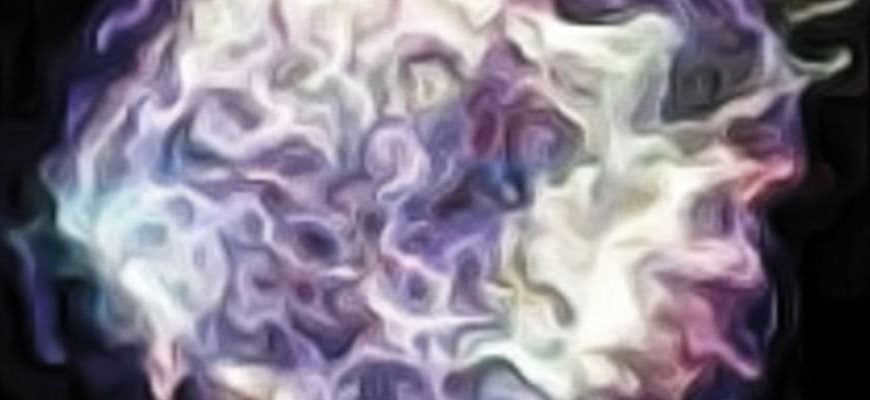
A brilliantly luminous celestial object suddenly bursts forth in the nocturnal expanse. It was absent just a few hours ago, but now it radiates like a guiding light.
This radiant celestial object is no longer truly a celestial object. It is a radiant point of illumination resulting from the explosive demise of a star that has reached the culmination of its existence, and is commonly referred to as a supernova.
Supernovae have the ability to momentarily outshine entire galaxies and emit more energy than the entirety of our sun’s lifespan. They are also the primary origin of heavy elements within the cosmos. According to NASA, supernovae represent “the most substantial explosion that can manifest within the realms of outer space.”
A Brief Account of Supernova Observations in History
Supernovae have been documented by various civilizations long before the advent of telescopes. The earliest recorded supernova, known as RCW 86, was observed by Chinese astronomers in 185 AD. Their historical records indicate that this celestial event, often referred to as the “new star,” remained visible in the sky for a remarkable duration of eight months.
Prior to the availability of telescopes in the early 17th century, seven supernovae had been officially recorded, as documented in the Encyclopedia Britannica.
One of the most renowned supernovae, now known as the Crab Nebula, is the remnants of a stellar explosion that was meticulously documented by Chinese and Korean astronomers in the year 1054. There is also evidence to suggest that the indigenous Southwestern Indians, as evidenced by rock paintings found in Arizona and New Mexico, may have witnessed this awe-inspiring event. The brightness of the supernova was so extraordinary that it could even be observed during daylight hours by astronomers.
There were other supernovae that were discovered prior to the invention of the telescope, including occurrences in 393, 1006, 1181, 1572, and in 1604. The renowned astronomer Tycho Brahe documented the most recent one in his book “De Stella Nova”, which led to the term “nova”. It is important to note that a nova is distinct from a supernova. Both events involve sudden surges in brightness as hot gases surge outward. However, a supernova is a catastrophic explosion that signifies the end of a star’s evolution.
The term “supernova star” was not coined until the 1930s. It was initially used by Walter Baade and Fritz Zwicky from the Mount Wilson Observatory. They witnessed a phenomenon resembling an explosion in outer space. This event was referred to as S Andromedae (also known as SN 1885A) and took place in the Andromeda galaxy. Baade and Zwicky theorized that supernovae occur when regular stars collide with neutron stars.
One of the most renowned supernovae is SN 1987A, which occurred in 1987. Astronomers continue to examine this event because it provides an opportunity to observe the evolution of a supernova in the first few decades following the explosion.
The demise of a celestial body
On an average note, a stellar explosion occurs approximately once every 50 years within a galaxy as vast as our Milky Way. In simpler terms, a star undergoes a cataclysmic event every second or thereabouts somewhere within the cosmos. However, due to their great distance from Earth, these occurrences remain unseen by the human eye.
Approximately 10 million years in the past, a cluster of stellar explosions gave rise to a “local bubble” spanning a distance of 300 light-years. This expansive region consists of gaseous matter within the interstellar medium, enveloping the entirety of the solar system.
It is widely known that the fate of a star is determined, in part, by its mass. For instance, our Sun lacks the necessary mass to undergo a supernova explosion. Unfortunately, the outlook for Earth is not optimistic. Once the Sun exhausts its thermonuclear fuel (which is expected to happen in a few billion years), it will expand into a red giant, likely obliterating our planet before gradually cooling and transforming into a white dwarf.
However, a star with the appropriate mass can experience a fiery demise.
A star can go supernova through one of two mechanisms:
- Type I supernova: the star accumulates matter from its companion until a violent nuclear reaction occurs.
- A typical supernova: the star depletes its nuclear fuel, causing it to collapse under the force of its own gravity.
Type II supernovae
Let’s start by examining the more captivating form of supernova – Type II. In order for a star to undergo a Type II supernova event, it must possess a mass several times greater than that of the Sun (estimates suggest between 8 and 15 solar masses). Similar to the Sun, it will undergo fusion of hydrogen and then helium. Furthermore, it will have sufficient mass and pressure to synthesize carbon. Here is what transpires next:
- Gradually, the core will begin to produce heavier elements, resulting in a layered structure akin to an onion. The lighter elements will be arranged in descending order of mass towards the outer regions of the star.
- Once the core of the star surpasses a certain mass threshold known as the Chandrasekhar limit, it will undergo a cataclysmic explosion (hence why these supernovae are also referred to as “supernovae”).
- The core will undergo a substantial increase in temperature and density.
- Eventually, the matter rebounds off the core and propels the stellar material outward, resulting in the formation of a supernova.
What is left behind after the explosion is an extremely dense object known as a neutron star. Neutron stars are about the size of a small city but can contain the mass of the Sun within a small space.
There are different subcategories of Type II supernovae, which are classified based on their light curves. Type II-L supernovae exhibit a gradual decrease in brightness after the explosion, while Type II-P supernovae maintain a steady level of brightness for a period of time before fading. Both types of supernovae have a hydrogen line in their spectra.
Astronomers theorize that stars with a much higher mass than the Sun (around 20-30 solar masses) do not explode as supernovae, but instead collapse and form black holes.

